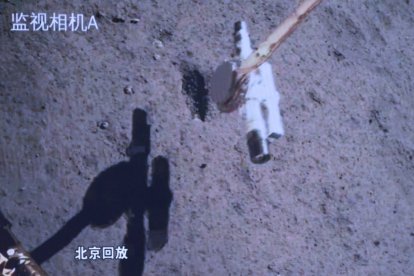The Chinese Chang'e-6 probe takes off from the Moon with samples from its hidden side
According to mission spokesman Ge Ping, the analysis of the tests will allow scientists to "deepen the investigation of the formation and historical evolution" of the satellite.

(Cordon Press)
(AFP/VOZ MEDIA ) The Chinese probe Chang'e-6 successfully took off from the Moon carrying samples taken on the hidden side of the Earth's satellite, something unprecedented in space exploration, the Chinese state press reported this Tuesday.
The milestone represents a new step in China's ambitious space program, which was already the first country to place a probe on that part of the Moon and plans to send a manned mission to the satellite in 2030.
"The ascension module of China's Chang'e-6 probe lifted off from the lunar surface on Tuesday morning, carrying samples collected on the far side of the Moon," state news agency Xinhua said, citing the China National Space Administration (CNSA).
"The mission has passed the high temperature test on the far side of the Moon," said the Chinese space agency.
The analysis of the samples it collected will allow scientists to "deepen the investigation of the formation and historical evolution of the Moon," said mission spokesman Ge Ping, quoted by Xinhua.
It will also provide information on "the origin of the solar system, with a better basis for subsequent exploration missions," he added.
The Chang'e-6 probe landed on Sunday in the immense Aitken Basin, one of the largest known impact craters in the solar system, located on the far side of the satellite, according to the CNSA.
The ship, which began a complex 53-day mission on May 3, had a robotic arm to collect material from the surface and a drill to take samples from its interior.
Chinese flag on the Moon
After collecting this material, "a Chinese national flag carried by the lunar landing module was displayed for the first time on the far side of the Moon," Xinhua said.
The CSNA did not specify how the mission will continue but, according to specialized portals, the probe will continue in lunar orbit for a few weeks before beginning its return to Earth around June 25.
Scientists consider that this part of the Moon, never visible from Earth, has great potential for research because its craters are not as covered by ancient lava flows as those on the side closest to the planet.
Since coming to power, the president of China, Xi Jinping, has promoted the "space dream" of the Asian giant.
The country has allocated enormous resources in the last decade to close the gap with the two traditional powers in this sector, the United States and Russia.
Along the way it has achieved notable successes such as the construction of the Tiangong space station, the landing of space exploration robots on Mars and the Moon and the sending of manned missions to orbit.
The United States assures that China's aerospace program hides military objectives and seeks to establish the Asian country's dominance in space.
The latest Chang'e-6 mission is part of renewed interest in the Moon, where China wants to send astronauts in 2030 and plans to build a space base.
The United States also wants to return humans to the Moon in 2026 with its Artemis 3 mission.
RECOMMENDATION





















